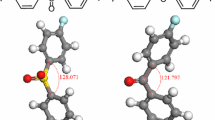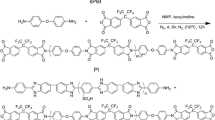Abstract
Polymers comprised of phosphonic acid units are generally preferred for proton conducting membranes due to their high proton conductivity in humidified and anhydrous state. Polymers based on 4-vinylbenzene boronic acid and diisopropyl-p-vinylbenzyl phosphonate were synthesized and the phosphonate group was hydrolyzed. Boronic acid groups were grafted with polyethyleneglycol methyl ether (PEGME) to produce more flexible copolymers. The copolymerization and grafting reactions were verified by Fourier Transform infrared spectroscopy, thermogravimetric analysis and differential scanning calorimetry (DSC). The P content of the samples was analyzed with SEM–EDS. Thermograms indicate that the copolymers are thermally stable to 200 °C. In addition, grafting resulted in the inhibition of condensation of the acidic units. DSC results show that after grafting the copolymers have distinct melting temperatures corresponding to PEGME units, which are bound to the polymer. The ion exchange capacity and cyclic voltammetry of the copolymers results were measured. The proton conductivity of the copolymers was investigated in the anhydrous state. Although the copolymers have low proton conductivity (<10−10 S/cm), they reached a value of 1.6 × 10−6 S/cm after grafting with PEGME units. This demonstrated that the presence of flexible side units increased the proton conductivity at least five orders of magnitude. This idea can be used for designing the novel membranes for fuel cells.













Similar content being viewed by others
References
S.Ü. Celik, A. Bozkurt, S.S. Hosseini, Prog. Polym. Sci. 37, 1265 (2012)
C.L. Gardner, A.V. Anantaraman, J. Electroanal. Chem. 449, 209 (1998)
H. Pu, Y. Qin, D. Wan, Z. Yang, Macromolecules 42, 3000 (2009)
S.H. Kim, Y.C. Park, G.H. Jung, C.G. Cho, Macromol. Res. 15, 587 (2007)
B.P. Tripathi, A. Saxena, V.K. Shahi, J. Membr. Sci. 318, 288 (2008)
H.R. Allcock, M.A. Hofmann, C.M. Ambler, R.V. Morford, Macromolecules 34, 6915 (2001)
A. Bozkurt, W.H. Meyer, J. Gutmann, G. Wegner, Solid State Ionics 164, 169 (2003)
S.Ü. Çelik, Ü. Akbey, R. Graf, A. Bozkurt, H.W. Spiess, Phys. Chem. Chem. Phys. 10, 6058 (2008)
P. Jain, V. Choudhary, I.K. Varma, J. Macromol. Sci. Polym. Rev. 42, 139 (2002)
S.Y. Lu, I. Hamerton, Prog. Polym. Sci. 27, 1661 (2002)
M. Sacristán, J.C. Ronda, M. Galià, V. Cádiz, Polymer 51, 6099 (2010)
D. Roy, B.S. Sumerlin, ACS Macro Lett. 1, 529 (2012)
J.P. Lorand, J.O. Edwards, J. Org. Chem. 24, 769 (1959)
C. Cui, E.M. Bonder, Y. Qin, F. Jaekle, J. Polym. Sci. Part A 48, 2438 (2010)
A. Sezgin, Ü. Akbey, M.R. Hansen, R. Graf, A. Bozkurt, A. Baykal, Polymer 49, 3859 (2008)
A. Sezgin, Ü. Akbey, R. Graf, A. Bozkurt, A. Baykal, J. Polym. Sci. Part B 47, 1267 (2009)
S.P. Brown, I. Schnell, J.D. Brand, K. Mullen, H.W. Spiess, J. Am. Chem. Soc. 121, 6712 (1999)
S.U. Celik, A. Bozkurt, Solid State Ionics 181, 987 (2010)
D.K. Pradhan, R.N.P. Choudhary, B.K. Samantaray, Mater. Chem. Phy. 115, 57 (2009)
P.S. Anantha, K. Hariharan, Mater. Chem. Phy. 89, 428 (2005)
G. Scharfenberger, W.H. Meyer, G. Wegner, M. Schuster, K.D. Kreuer, J. Maier, Fuel Cells 3–4, 237 (2006)
J.C. Persson, P. Jannasch, Chem. Mater. 15, 3044 (2003)
C.A. Alabi, Z. Chen, Y.S. Yan, M.E. Davis, Chem. Mater. 21, 4645 (2009)
Acknowledgments
This work was supported by National Boron Research Institute (BOREN) under contact number 2011. Ç0295 and partially supported by the Turkish Academy of Sciences (TÜBA).
Author information
Authors and Affiliations
Corresponding author
Rights and permissions
About this article
Cite this article
Çelik, S.Ü., Bozkurt, A. Enhancing the Anhydrous Proton Conductivity of Boronic and Phosphonic Acid Functional Copolymers by Grafting With Flexible Spacers. J Inorg Organomet Polym 23, 846–854 (2013). https://doi.org/10.1007/s10904-013-9851-8
Received:
Accepted:
Published:
Issue Date:
DOI: https://doi.org/10.1007/s10904-013-9851-8




